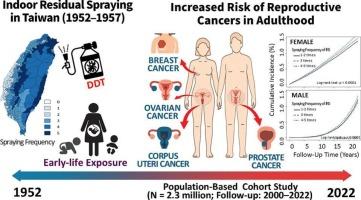早期接触二氯二苯三氯乙烷(DDT)增加生殖癌风险:来自台湾历史人群研究的证据(1952-1957)
IF 8
1区 环境科学与生态学
Q1 ENVIRONMENTAL SCIENCES
引用次数: 0
摘要
二氯二苯三氯乙烷(DDT)在1952年至1957年期间在台湾广泛用于疟疾控制,导致广泛的早期接触。有限的证据表明,在发育关键期接触滴滴涕可能会增加成年期内分泌相关恶性肿瘤的风险。根据历史室内残留喷洒记录估计DDT暴露水平,并根据乡镇一级喷洒频率(0-5次)将其分为6组。应用Kaplan-Meier生存分析和Cox比例风险模型来估计生命早期DDT暴露与生殖癌累积发病率之间的关系。在22年的随访期间(2000 - 2022年),确定了81,592例生殖癌病例。每增加一次镇级滴滴涕喷洒与癌症风险升高显著相关(女性aHR: 1.04, 95% CI: 1.03-1.04;男性aHR: 1.05, 95% CI: 1.03-1.07)。在女性中,乳腺癌(aHR: 1.04, 95% CI:1.03 - 1.05)、子宫(aHR: 1.03, 95% CI: 1.01-1.05)和卵巢癌(aHR: 1.06, 95% CI: 1.02-1.09)的相关性最强。在男性中,前列腺癌的风险最高(aHR: 1.05, 95% CI: 1.03-1.07)。观察到显著的剂量-反应趋势(p <;0.0001)。这一历史暴露环境基于一个独特的背景和一个全国性的数据库,为早期DDT暴露与长期致癌风险之间的潜在关联提供了流行病学证据。这些发现为来自亚洲的有限证据提供了依据,并强调了在仍在进行滴滴涕喷洒的国家进行长期监测的必要性。本文章由计算机程序翻译,如有差异,请以英文原文为准。

Increased reproductive cancer risks following early-life dichlorodiphenyltrichloroethane (DDT) exposure: Evidence from a historical population-based study in Taiwan (1952–1957)
Dichlorodiphenyltrichloroethane (DDT) was extensively applied for malaria control in Taiwan between 1952 and 1957, resulting in widespread early-life exposure. Limited evidence suggests that exposure to DDT during critical developmental windows may increase the risk of endocrine-related malignancies in adulthood. To investigate this association, we conducted a left-truncated cohort study utilizing Taiwan's National Health Insurance Research Database (NHIRD), including 2,327,099 individuals born during the DDT-based malaria eradication campaign. DDT exposure levels were estimated from historical indoor residual spraying records and categorized into six groups based on township-level spraying frequency (0–5 times). Kaplan–Meier survival analysis and Cox proportional hazards models were applied to estimate the association between early-life DDT exposure and the cumulative incidence of reproductive cancers. Over a 22-year follow-up (2000−2022), 81,592 reproductive cancer cases were identified. Each additional episode of township-level DDT spraying was significantly associated with an elevated cancer risk (aHR: 1.04, 95 % CI: 1.03–1.04 in women; aHR: 1.05, 95 % CI: 1.03–1.07 in men). Among women, breast (aHR: 1.04, 95 % CI:1.03–1.05), corpus uteri (aHR: 1.03, 95 % CI:1.01–1.05), and ovarian cancers (aHR: 1.06, 95 % CI:1.02–1.09) showed the strongest associations. In men, prostate cancer demonstrated the highest risk (aHR: 1.05, 95 % CI:1.03–1.07). A significant dose–response trend was observed (p < 0.0001). This historical exposure setting, grounded in a unique context and a nationwide database, provides epidemiologic evidence on the potential association between early-life DDT exposure and long-term carcinogenic risk. The findings contribute to the limited body of evidence from Asia and underscore the need for long-term surveillance in countries where DDT spraying is still ongoing.
求助全文
通过发布文献求助,成功后即可免费获取论文全文。
去求助
来源期刊

Science of the Total Environment
环境科学-环境科学
CiteScore
17.60
自引率
10.20%
发文量
8726
审稿时长
2.4 months
期刊介绍:
The Science of the Total Environment is an international journal dedicated to scientific research on the environment and its interaction with humanity. It covers a wide range of disciplines and seeks to publish innovative, hypothesis-driven, and impactful research that explores the entire environment, including the atmosphere, lithosphere, hydrosphere, biosphere, and anthroposphere.
The journal's updated Aims & Scope emphasizes the importance of interdisciplinary environmental research with broad impact. Priority is given to studies that advance fundamental understanding and explore the interconnectedness of multiple environmental spheres. Field studies are preferred, while laboratory experiments must demonstrate significant methodological advancements or mechanistic insights with direct relevance to the environment.
 求助内容:
求助内容: 应助结果提醒方式:
应助结果提醒方式:


